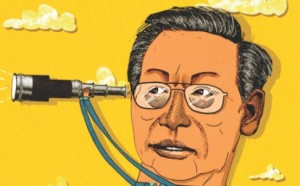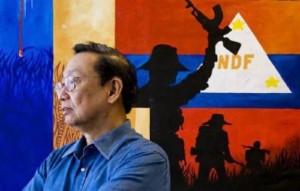
Exiled Communist Party of the Philippines founder Jose Maria Sison has been a political refugee in the Netherlands for nearly 28 years
Raissa Robles in Utrecht, The Netherlands
PUBLISHED : Sunday, 26 July, 2015, 4:34pm
UPDATED : Sunday, 26 July, 2015, 4:35pm
http://www.scmp.com/news/asia/southeast-asia/article/1843652/philippines-most-wanted-man-still-believes-revolutionary
In a working-class Dutch neighbourhood in Utrecht a few minutes walk from the central train station stands a small shop that looks abandoned from the outside. There’s nothing to indicate that behind the nondescript door and smudged glass window is the headquarters of the Philippines’ most wanted man, exiled Communist Party of the Philippines (CPP) founder Jose Maria Sison.
Its shabbiness, beside a costume rental shop and a store selling party favours, masks bold ambition: to take over the reins of government and install a socialist society in the Philippines.

“In a socialist society,” Sison says, “there are still certain classes such as those of the workers and peasants but these are no longer subject to the ruling exploiting classes. Incomes are still earned according to the quantity and quality of work done. The reduction of working hours is accomplished from stage to stage. Social services and cultural facilities keep on expanding. There is still a state that defends society from counter-revolutionaries and imperialist aggressors.”
With nearly one of every four Filipinos still living below the poverty line and a mere 3 per cent of the 100 million population owning a majority of the nation’s wealth, Sison’s message still finds fertile ground among the working class, university students and in remote villages populated by indigenous ethnic groups.
Take the Manobo tribe on the southern island of Mindanao, which is currently fighting to keep its school open despite pressure from the Philippine Armed Forces. The military insists that the CPP’s armed wing, the New People’s Army (NPA), now secretly runs the school and uses it to teach subversive ideas and recruit Manobos.
Lila Shahani, an assistant secretary of the National Anti-Poverty Commission under the Office of the President, says there is some truth to the soldiers’ claim: “Current military figures estimate that out of a total 1,866 NPAs active in the Northern Mindanao region, 74 per cent are IPs (indigenous persons).”
However, the Oxford-educated official – who happens to be a niece of former President Fidel Ramos – said the government is failing to address the root cause of the Manobos’ discontent, namely, the exploitation of their land by one of the country’s billionaires.
“So long as these deep structural issues persist, Manobos and others like them will turn to groups like the NPA, or other home-grown insurgencies, for relief and defence,” Shahani warns.
Ironically, Sison comes from the very class which he seeks to overthrow. His family owned vast tracts of land and traces its ancestry to a Chinese trader who sailed from Fujian.

Sison says he would not have escaped the narrow ambition of his class if not for his village barber. As his barber cut his hair, he regaled the young Sison with stories about the Huks or armed guerrillas who fought for their land in Central Luzon, north of Manila.
“My barber talked about the need for the workers and peasants to overthrow the big capitalists and landlord class by armed force because, in the first place, these exploiting classes use violence to perpetuate their system against the working people,” said Sison in an interview last week.
“What the barber said complemented what I heard from farm workers who had returned to my hometown after a stint of being tabaseros (sugar cane cutters) in Central Luzon. They said that the Huks were good, for advocating the free distribution of land to the tillers,” Sison recalled.
Read more: Exiled Philippine communist leader Sison blasts ‘greedy’ China over sea dispute
At 20, while studying for a degree in English and literature at the University of the Philippines, Sison organised his first group, the Student Cultural Association of the Philippines.
According to Ninotchka Rosca – co-author with Sison of his semi-autobiographical book Jose Maria Sison: At Home in the World, Portrait of a Revolutionary – it was Sison who “made acceptable the concepts of mass organisations and mass mobilisations”.
The works of Marx, Lenin and Mao Zedong would inspire Sison to come up with a Filipino version of protracted armed struggle. However, Sison’s revolution would be exploited by President Ferdinand Marcos, whose family comes from the same region as Sison. In 1972, Marcos imposed military rule, claiming he was saving the Philippines from a Sison-led revolution. Five years later in 1977, Sison would fall into Marcos’s hands.
Sison recalled that Marcos spoke to him in Ilocano, “perhaps to show that we belonged to the same tribe”. But Sison responded in English and Filipino.
Marcos tried to flatter his prisoner saying, “I’ve been reading your works, your writings” and hinted that the two were not so far apart in thought and could cooperate together.
He said he replied to Marcos: “Yes, if it’s for the people we can cooperate. If you keep on borrowing lots of money from abroad, some day the US will dump you when you become more of a liability than an asset.”
Marcos told him, “You talk like an Aquino”, referring to the late Senator Benigno Aquino, father of the incumbent President Aquino. Marcos would have his revenge on Sison. He was beaten, given water torture, electric shock treatment and shackled to a cot for 18 months in solitary confinement.
Sison was also tried, along with the elder Aquino, before a military court. Then, in 1983, the unexpected: Aquino was shot as he disembarked a plane surrounded by soldiers at Manila’s airport, setting in motion the chain of events that would lead to Marcos’s ouster. Three years later, Sison was conditionally released from jail by Aquino’s widow, President Corazon Aquino, pending peace talks with the communist rebels.
But while on a world tour, Sison’s Filipino passport was revoked. He and his wife Julieta de Lima have been political refugees in the Netherlands for nearly 28 years since.
Does he dream of going back? “I do not just dream, even in the sense of imagining a better world that can arise from the people’s struggle,” Sison, now 76, replied.
“I deal with realities and do whatever I can in the revolutionary struggle of the people.”
“Like Lenin before the outbreak of the first world war, I am not sure whether the revolution would win in my lifetime,” he said. “But I am sure that the neoliberal policy of imperialist globalisation, the wars of aggression and the intensified inter-imperialist contradictions are already generating the conditions for an unprecedented upsurge of the revolutionary movements for national liberation, people’s democracy and socialism.”
To Sison, no country has established a truly communist state. “It is simply journalistic parlance in the Western media to call communist a state or society governed by a communist party,” he said.
Should his group ever come to power, Sison describes his vision: “There can be a model for a people’s democratic system gliding into socialist revolution and construction. This model can be a composite of the best features of the people’s democracies and socialist societies that have arisen in history before the successful betrayal of socialism by modern revisionists. More importantly, the model takes into account the history, circumstances and aspirations of the Filipino people.”
Having bedevilled six Philippine presidents, Sison’s party may yet continue to hound the next.Philippines’ most wanted man still believes in the revolutionary struggle